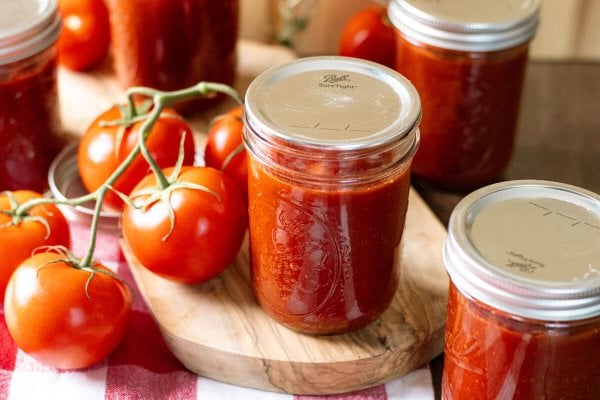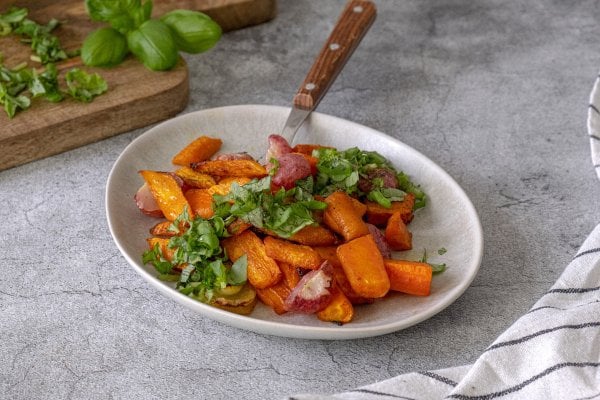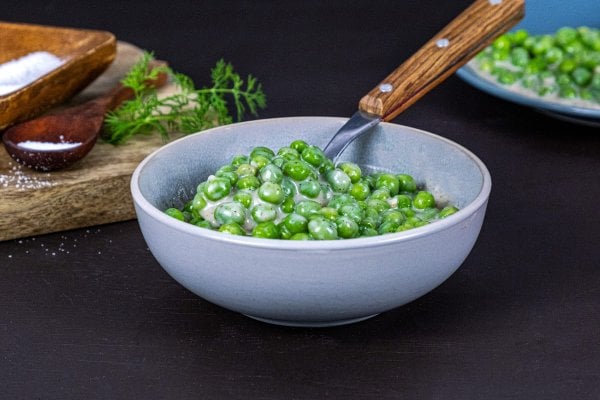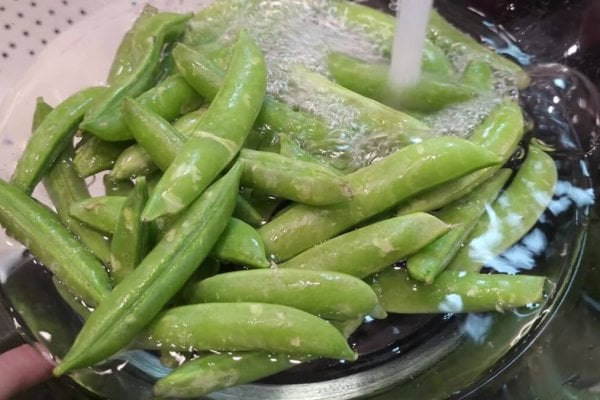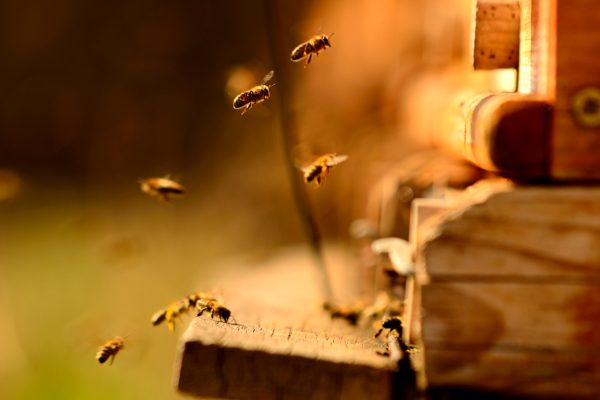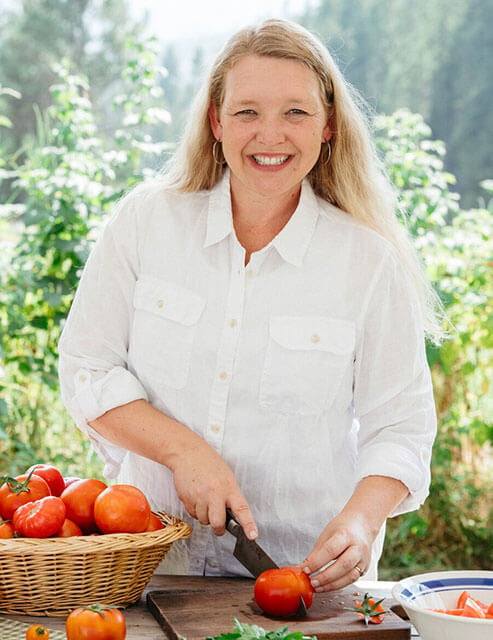Learning how to make mustard at home with mustard seed and powdered mustard is simple, and the taste is so much better than store-bought. With this base recipe, you can make stone-ground mustard, Dijon mustard, spicy mustard and even sweet honey mustard. Trust me when I say that once you make it, you’ll never go back!
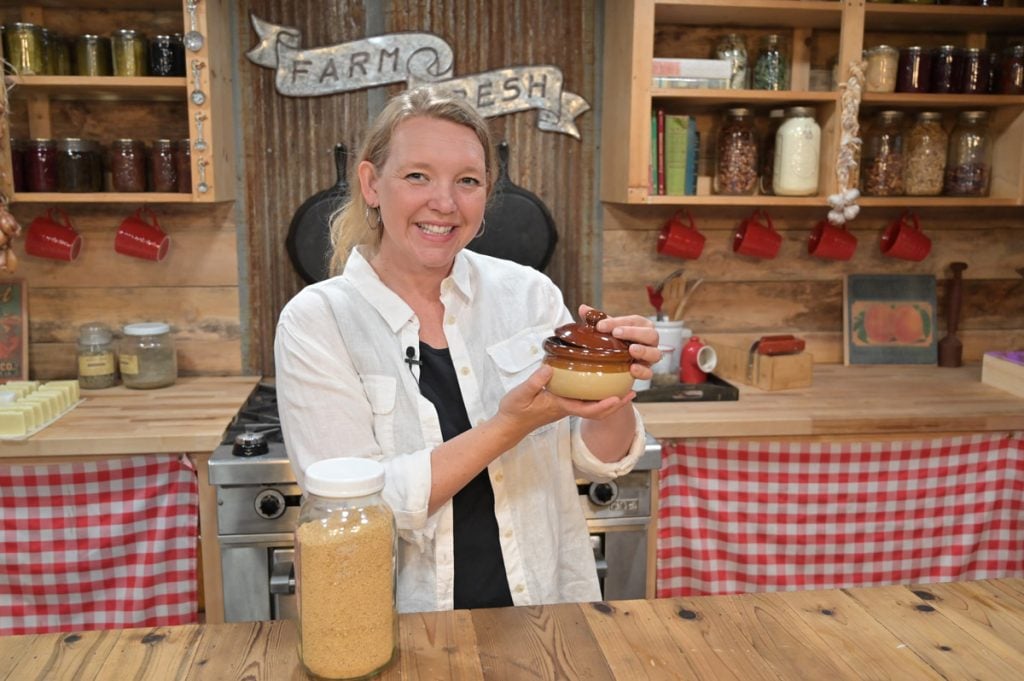
Why You Should Learn How to Make Mustard
A really great way to save money at the grocery store is to stop buying pre-packaged foods and start making your own. We’ve shared how to make homemade mayonnaise, homemade ketchup, this easy BBQ sauce recipe, fermented Sriracha, fermented asparagus relish, non-stick cooking spray, homemade garlic salt, homemade celery salt, and onion powder. Our cupboards are looking very homemade!
I know you’ve heard it before, but the truth is, once you make homemade ingredients from scratch, you’ll never want to buy them from the store again.
If you purchase mustard seeds in bulk, you’ll also save a lot on something as simple as homemade yellow mustard. Don’t be concerned about having a ton of mustard seeds on hand. They’ll last forever and can be used for making homemade pickles, mustard plaster for congestion, and creating all kinds of delicious homemade mustards.
I like to use this mustard in my homemade salad dressings, healthy broccoli salad and delicious green bean salad.
Types of Mustard
When you learn how to make mustard, you can make several varieties that provide different flavor profiles. Each type of mustard offers a unique flavor and texture, letting you experiment and find your favorite. Here are some varietions to try.
| Mustard Type | Flavor Profile | Common Uses |
| Yellow Mustard | Mild, Tangy | Hot dogs, Sauces |
| Dijon Mustard | Smooth, Spicy | Dressings, Sandwiches |
| Spicy Mustard | Robust, Fiery | Sausages, Vinaigrettes |
| Whole Grain Mustard | Textured, Earthy | Charcuterie Boards, Sandwiche |
| Honey Mustard | Sweet, Tangy | Dipping Sauces, Glazes |

Choosing Mustard Seeds
It’s important to know that there are different types of mustard seeds to choose from. The three basic types are white, brown, and black.
- Yellow – Yellow mustard seeds (also called white mustard seeds) are milder and what traditional yellow American mustard is made from. The mustard is dyed yellow with turmeric or food dye.
- Brown – Brown mustard seeds are used for whole grain and Dijon mustards.
- Black – Black mustard seeds are much spicier and typically used in Indian cooking.

Choosing the Liquid
You can use water, beer, wine, apple cider vinegar, homemade vinegar, or even champagne. However, the type of liquid does not matter as much as the temperature. The cooler the liquid is, the spicier the mustard will be.
Use warm liquid if you want mild mustard. Use cold liquid if you want spicy mustard.
| Liquid | Flavor Profile | Uses |
| Cold Water | Sharp, Spicy | Classic Mustards |
| White Wine (or white wine vinegar) | Fruity, Mild | Gourmet Salads, Sandwiches |
| Apple Cider Vinegar | Sweet, Tart | Flavorful Condiments |
| White Vinegar | Clean, Sharp | Versatile Mustards |
| Fruit Juice | Sweet, Fruity | Salad Dressing, Sandwiches |
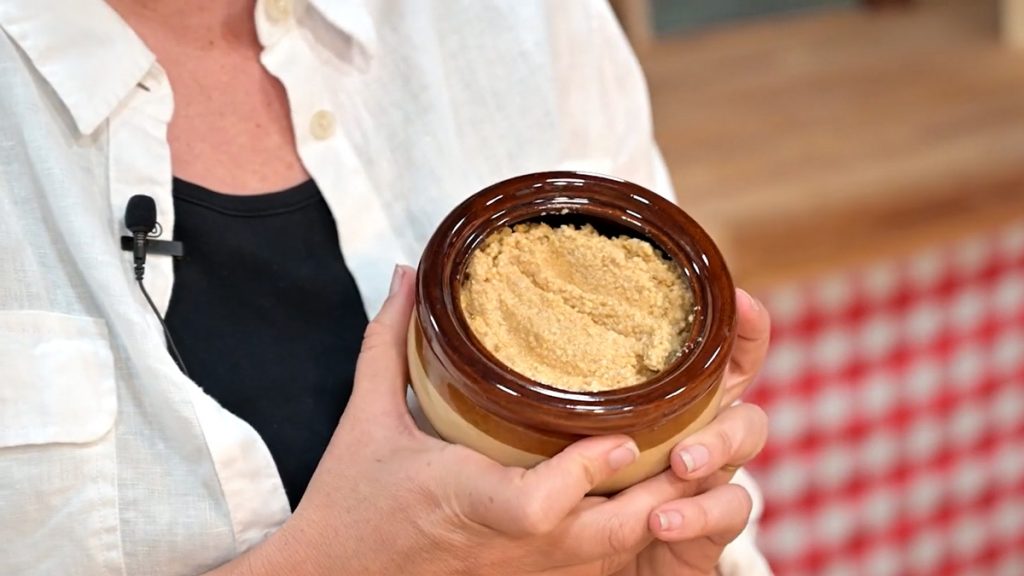
Mustard Variations
Mustards are very forgiving and flexible. For different flavors, try replacing the water with white wine, champagne, ale or even a kombucha! Try using different types of mustard seeds and even adding some sweetener like sugar, fruit puree or honey.
If you want to add herbs or fruit to your mustard, you can do so, but just know that it will no longer be shelf-stable and will need to be stored in the refrigerator.
Try adding fresh tarragon, garlic, or peppercorns for the herbs or add raspberries, apricots, or cranberries to give it a sweet twist. This fruity touch is great with grilled meats and cheese platters.
Homesteading Hack: I like to mix up this simple recipe, and then add my flavors in smaller batches (tip: let the mustard sit for about 15 minutes to absorb the flavors) so I don’t risk the entire batch spoiling before we can use it up.
You can make homemade honey mustard using this recipe as the base. Simply follow the instructions above, then combine equal parts mustard and honey and stir well. Enjoy!
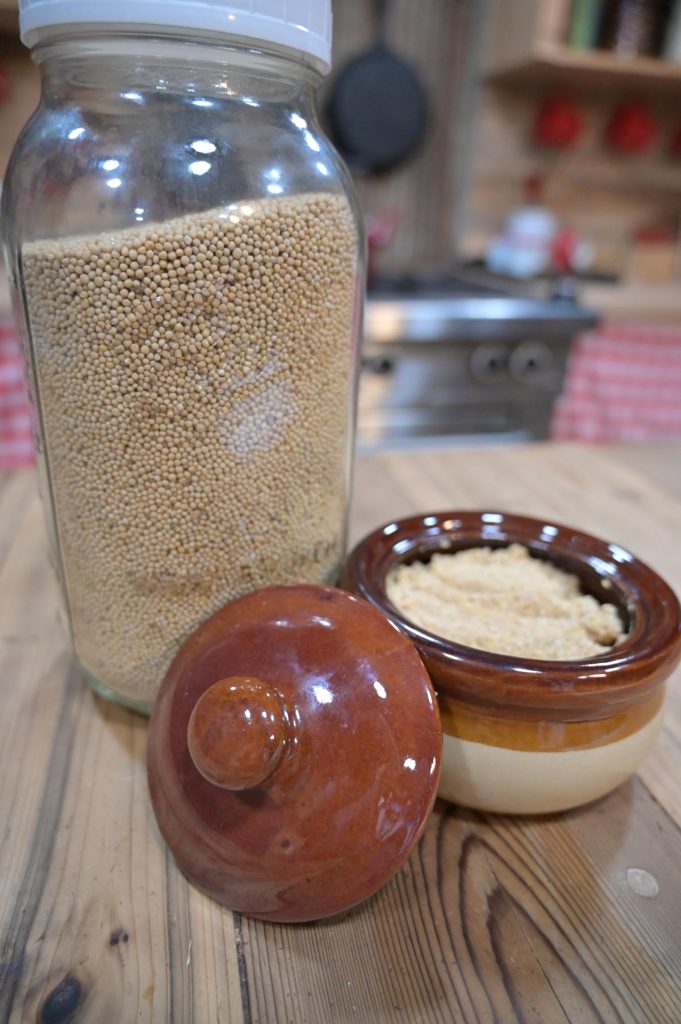
Tips for the Best Homemade Mustard
Learning how to make mustard includes some key recipe tips that you don’t want to skip.
- Room Temperature Ingredients – Start with room-temperature ingredients. This makes sure you get the best emulsification for the perfect consistency and flavor.
- Allow the Mustard to Rest – Let the mustard sit for at least 12 hours to allow the flavors to mix well and the mustard to thicken perfectly.
- Flavor Customization – Adjusting flavors to customize to your personal preference is key. Use these adjustments as needed.
- Add a bit of sugar or honey to soften the sharpness if it’s too strong.
- Try different kinds of vinegar (white, apple cider, balsamic) to match your taste.
- Add salt slowly and taste as you go. This keeps the flavors balanced without being too salty.
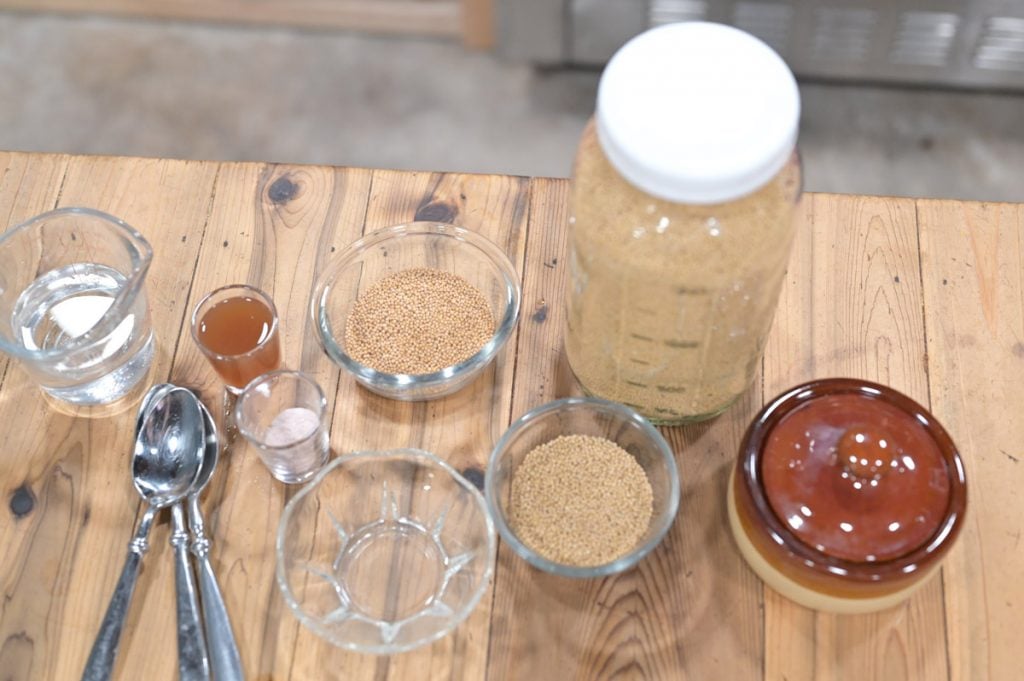
Supplies Needed
This recipe is for a small batch of mustard. If you want to make mustard on a large scale, a food processer may come in handy.
- Measuring Utensils – Use standard measuring cups and spoons.
- Mixing Bowl – A small bowl works great.
- Spice Grinder – This tool is needed only if you are making your own mustard powder. If you don’t have a spice grinder, you can also use a clean coffee grinder.
- Mortar & Pestle – You can use a coffee grinder if you don’t have a mortar & pestle on hand.
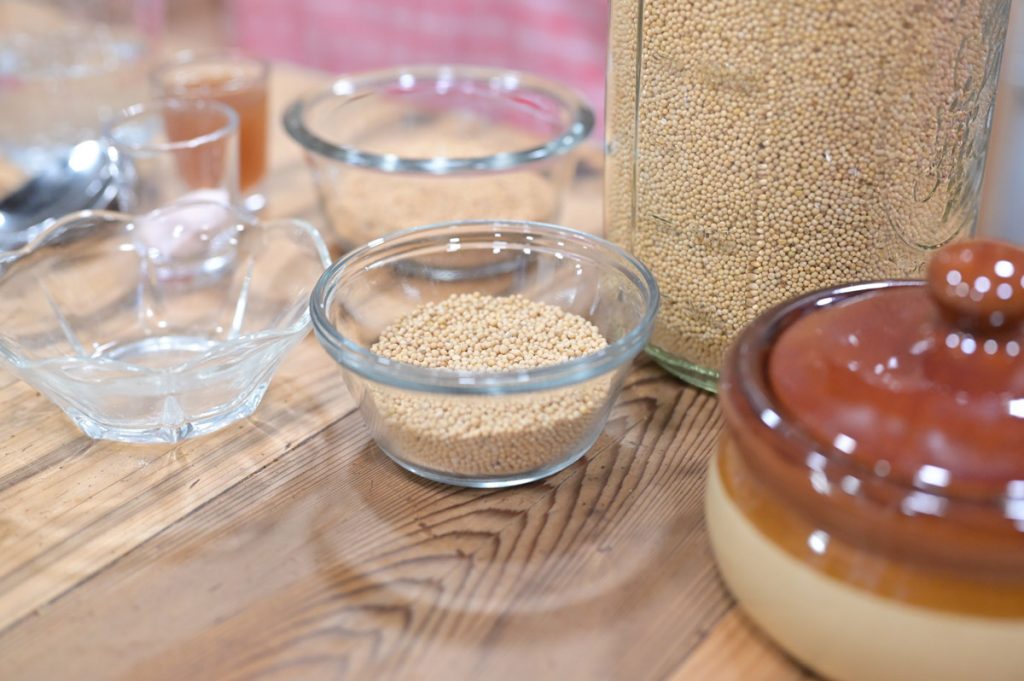
Ingredients Needed
- Mustard Seed – Mustard seeds need to be in whole form. You can buy mustard seeds here through Azure Standard.
- Mustard Powder – You can buy it or make your own – see instructions below. If you make your own, you will need 12 Tablespoons of mustard seed total.
- Liquid – You can use water, beer, wine, apple cider vinegar, or even champagne.
- Vinegar – I’m using apple cider vinegar, but you can use whatever vinegar you have on hand.
- Salt – If you’ve been with us for long, you probably notice how much we love our Redmond Real Salt. It’s the only salt we buy for both our family and our animals! Homesteading Hack: Using that link for Redmond Salt will automatically give you 15% off your order!
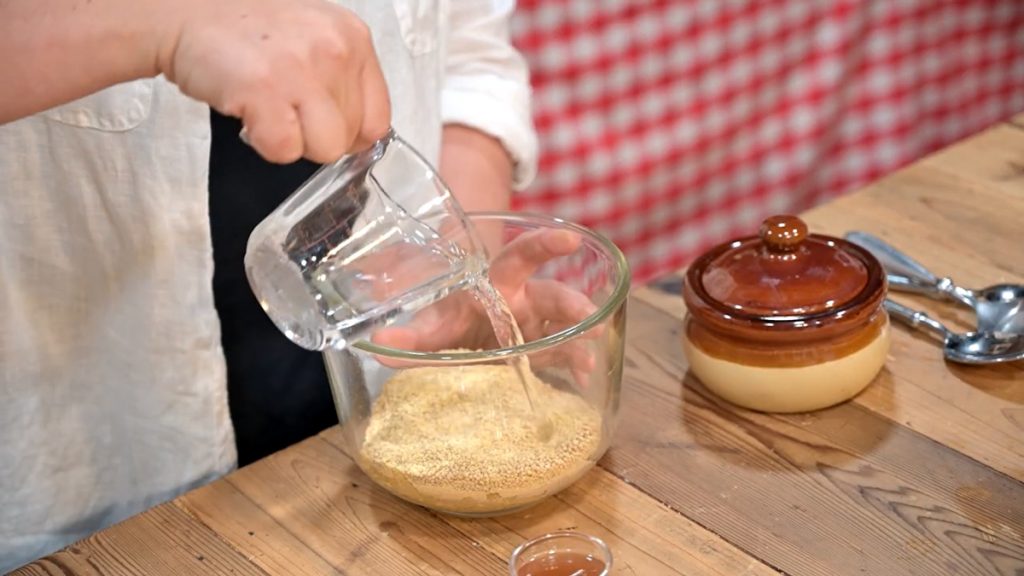
Homemade Mustard Recipe Instructions
- Divide your mustard seeds, keeping six tablespoons whole (for now) and six tablespoons to make your mustard powder.
- Grind your mustard seeds in a spice or coffee grinder until powdered and set aside in a bowl.
- With the other six tablespoons of mustard seeds, slightly grind them in a grinder, or use a mortar and pestle. You can leave some whole grains and then have some ground up. It depends on how you want your mustard texture to be.
- Add vinegar and additional liquid and mix well.
- If your mustard is too thick, you may need to add a bit more liquid.
- Cover and let sit for 12 to 24 hours in the refrigerator. Homesteading Hack: If your mustard is too thick after sitting, add more water or other liquid, 1 teaspoon at a time, to get your desired consistency.
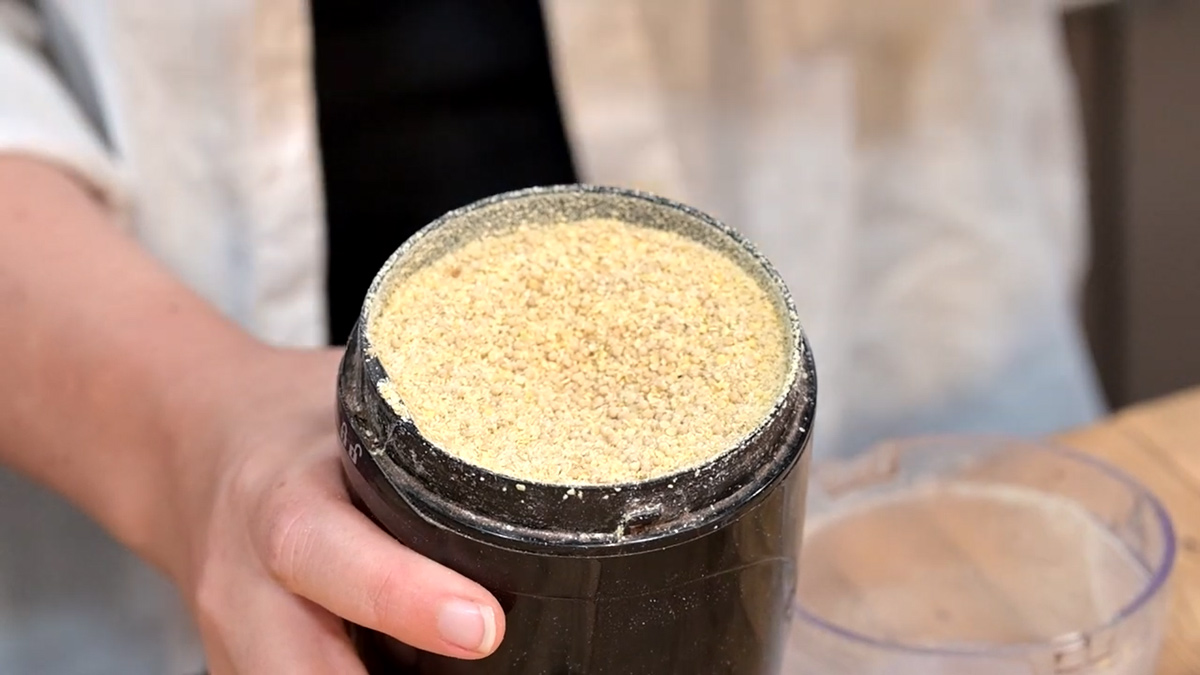
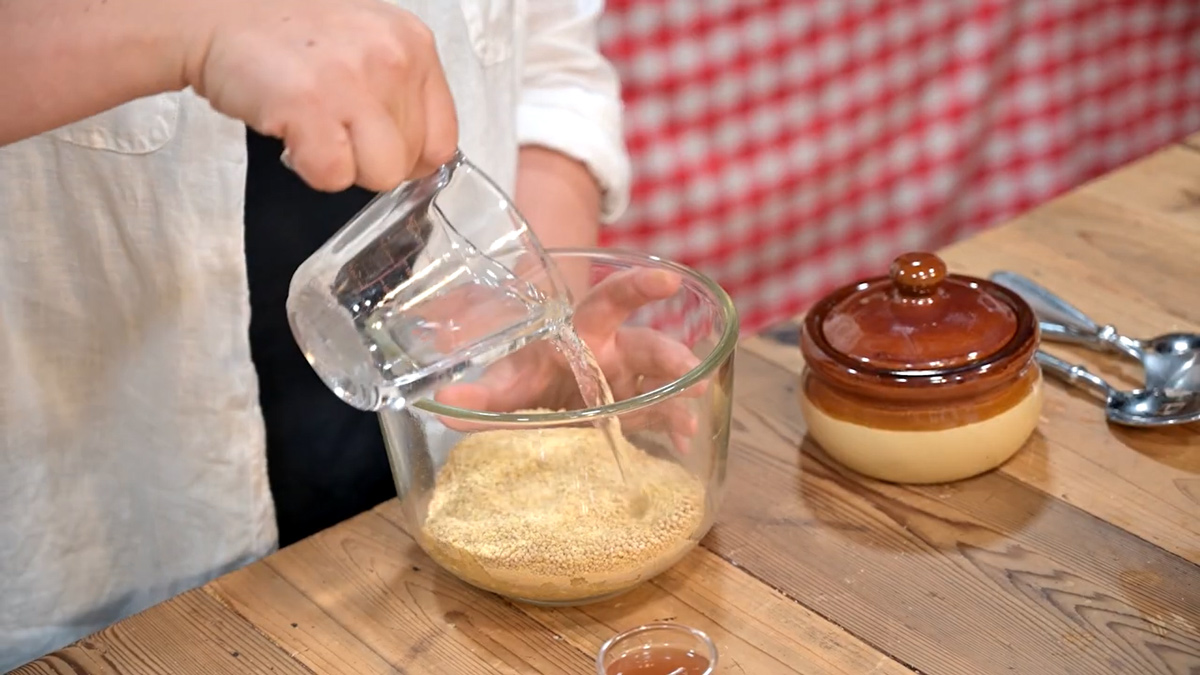
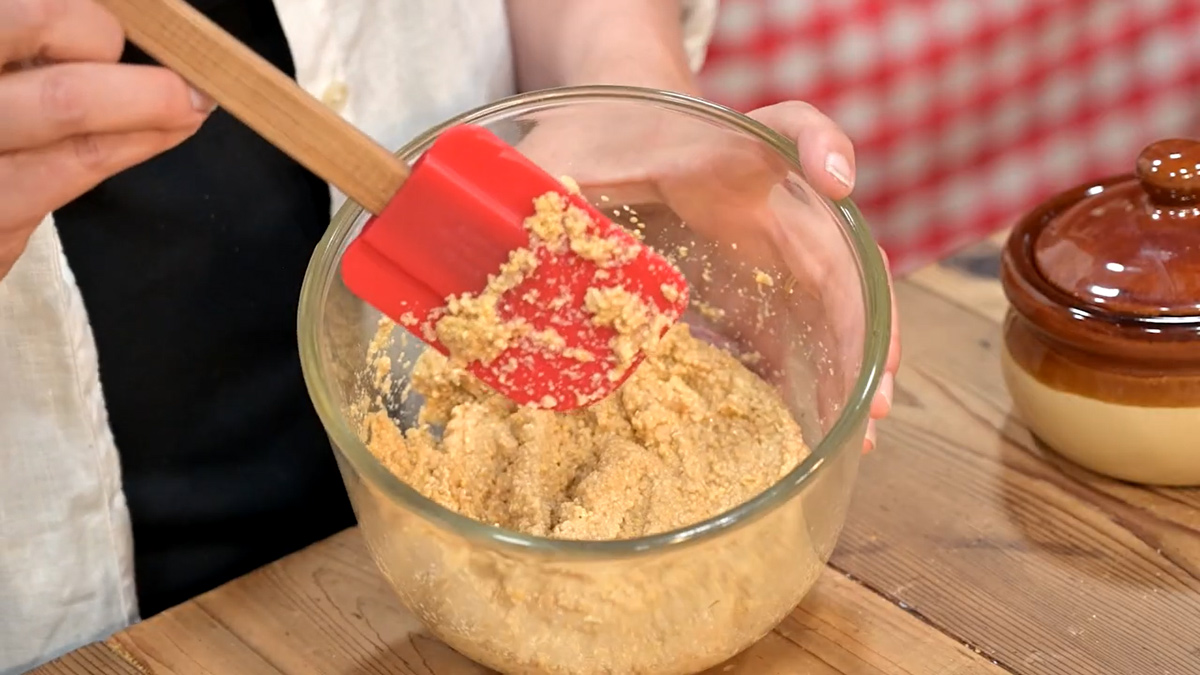
Storing Homemade Mustard
Homemade mustard is very shelf stable. But you will want to make sure you only use clean utensils when dipping into the jar to avoid contamination.
We like to place our mustard in the refrigerator for 24 hours to help it firm up, then transfer it to the counter to store at room temperature. If safe practices are followed, it should last at least a few months, but we always use ours up well before it has a chance to go bad.
If you’re concerned about storing it on the counter or in the pantry, you can always store it in the refrigerator.
Did you try this homemade mustard recipe? If so, please leave a star rating in the recipe card below. Then snap a photo and tag us on social media @homesteadingfamily so we can see!
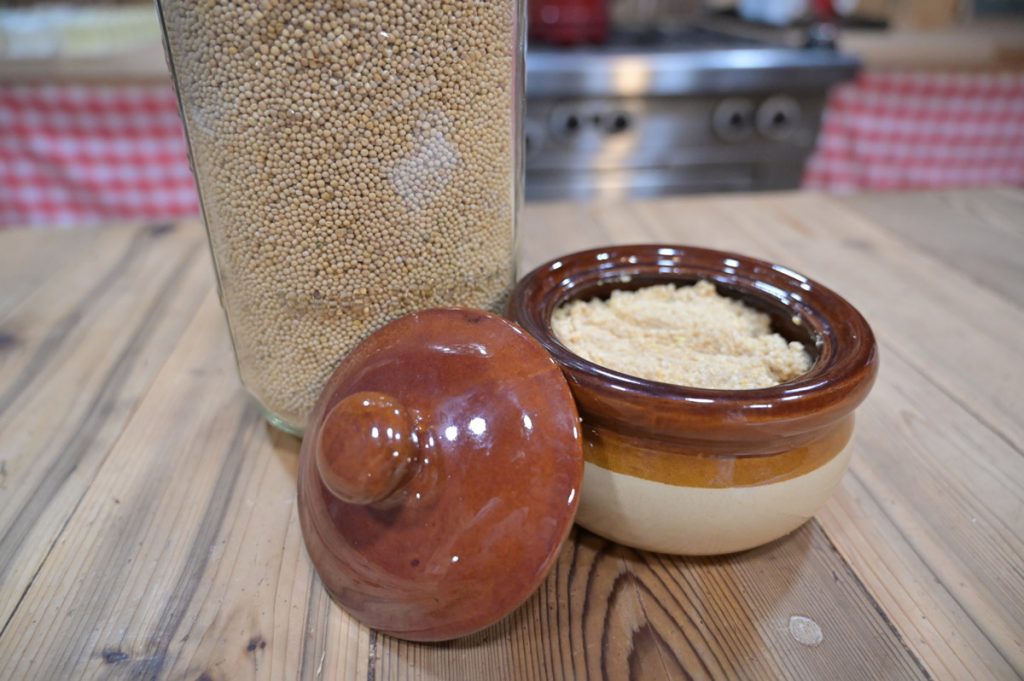
FAQ
The chemical reaction between mustard and liquid will make the mustard taste bitter. This bitterness will go away by storing the mustard in the refrigerator for 24 hours.
Yes! To make homemade mustard powder, simply grind mustard seeds in a spice grinder (or clean coffee grinder) until powdered. Just know that home-ground mustard powder is unlikely to be as fine as store-bought and will give you a great product that will look less like store-bought.
Making your own mustard lets you pick the flavors you like. It’s free from preservatives and can save money. Plus, it’s a fun DIY project.
You can make many types of mustard at home. This includes yellow mustard, spicy dijon, whole grain, and honey mustard. You can adjust each to your taste.
You can use yellow, brown, or black mustard seeds. Yellow seeds are mild, brown seeds are spicy, and black seeds are the hottest.
You can use cold water, white vinegar, apple cider vinegar, champagne, kombucha or white wine. Each adds a unique taste to your mustard.
You’ll need a spice or coffee grinder, a mixing bowl, and jars. A food processor can be used if making mustard on a large scale.
Yes, you can. There are tons of different flavor variations to suit your taste. Refer to the suggestions in this tutorial.
Homemade mustard is fresher and more vibrant. It’s free of preservatives and tailored to your taste.
Store it in airtight jars at room temperature or in the fridge. When stored in the fridge, it can last months without needing artificial preservatives.
Homemade mustard is so versatile. Use it in salad dressings, on sandwiches, as a dip, a marinade, or as a gourmet condiment. The options are endless!
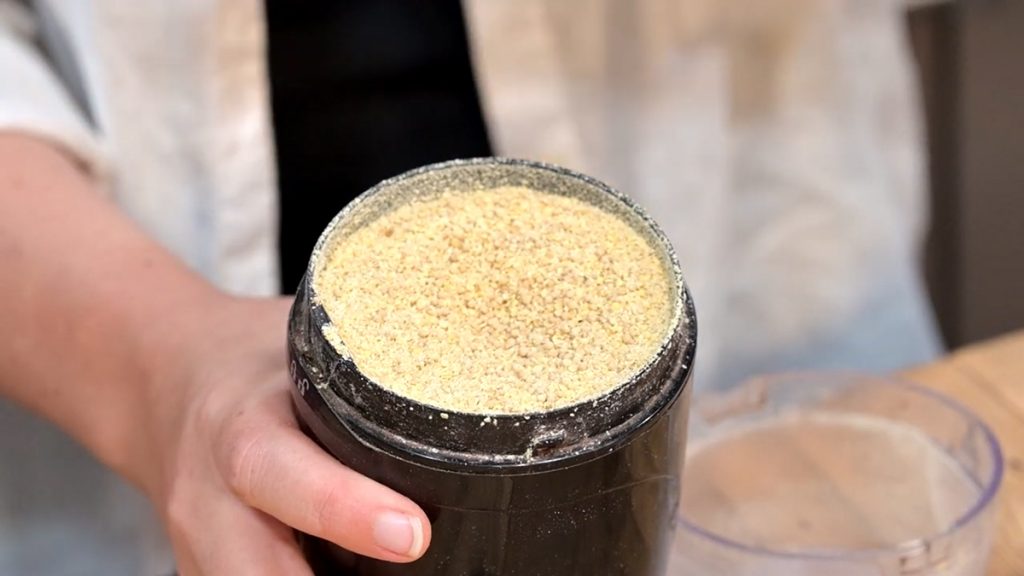
More Recipes You May Enjoy
- Homemade Mayonnaise
- Fermented Ketchup (Easy, Homemade, Probiotic & Kids Love It
- Fermented Sriracha Recipe (Easy, Homemade, Probiotic & Kids Love It)
- Easy Green Fermented Hot Sauce
- Green Tomato Salsa Recipe
- Homemade Vinaigrette Dressing (That Doesn’t Separate!)
- Homemade Mustard Plaster (For Chest Congestion Relief)
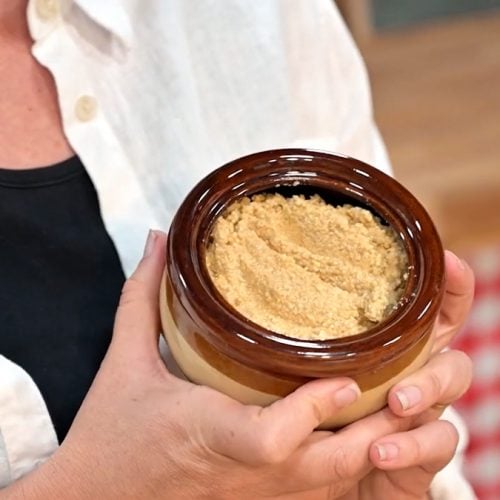
Homemade Mustard Recipe
Equipment
- Measuring Utensils
- Mixing Bowl
- Spice Grinder
- Mortar & Pestle
Ingredients
- 12 Tablespoons mustard seed divided
- 1/2 cup water or other liquid
- 3 Tablespoons apple cider vinegar or other vinegar
- 2 teaspoons salt
Instructions
- Divide your mustard seeds, keeping six tablespoons whole (for now) and six tablespoons to make your mustard powder. Grind six tablespoons mustard seeds in a spice or coffee grinder until powdered and set aside in a bowl.
- With the other six tablespoons of mustard seeds, slightly grind them in a grinder, or use a mortar and pestle. You can leave some whole grains and then have some ground up. It depends on how you want your mustard texture to be.
- Add vinegar and water (or other liquid) and mix well.
- If your mustard is too thick, you may need to add a bit more liquid.
- Cover and let sit for 12 to 24 hours in the refrigerator. Homesteading Hack: If your mustard is too thick after sitting, add more water or other liquid, 1 teaspoon at a time, to get your desired consistency.











